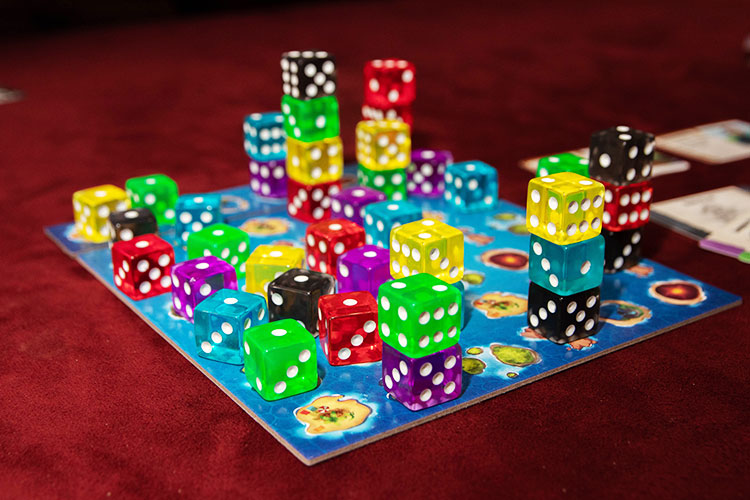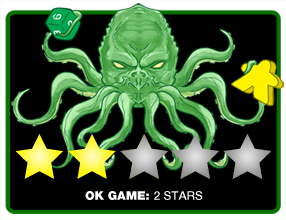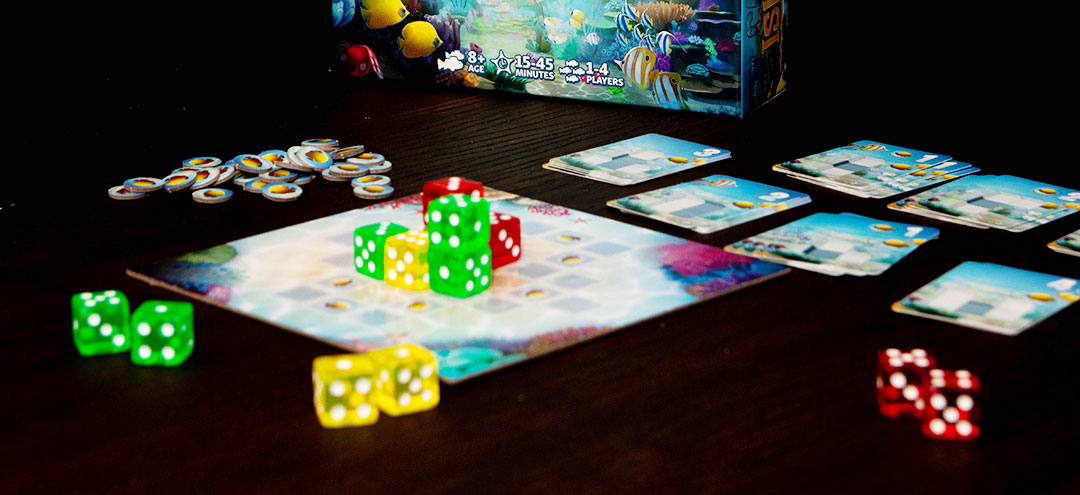 Board games are great. We all love them… or you likely wouldn’t be here. Today you get not just one, but two games in a single box. Coral Islands is really “Coral,” a dice placement game where you try to form a coral reef and “Islands” where you are creating a chain of islands and trying to stay above sea level.
Board games are great. We all love them… or you likely wouldn’t be here. Today you get not just one, but two games in a single box. Coral Islands is really “Coral,” a dice placement game where you try to form a coral reef and “Islands” where you are creating a chain of islands and trying to stay above sea level.
So do these two water-themed games make the perfect 2-in-1 deal? Or better left burying them in the sand? Let’s dive in…
Gameplay Overview:
Let’s start with Coral. Each player will have a pool of dice and roll two to be their available dice. On each turn, you’ll place a die on the reef either adjacent to an existing die or on top of a die of a lower value. One-value dice can always be placed on top of any stack, but each individual stack can only be three dice tall, maximum.
The goal is to complete one of the various structure cards that are available. These structures show specific patterns you must create using the dice in the reef. The light-colored dice on the pattern must be of your color and the darker-shaded ones have to belong to another player. You can’t flip or rotate in any way, so you have to carefully build off of the dice played by your opponents.

The other game—Islands—starts with a board covered in dice and three specialists that will each gather terrain cards under them. On your turn, you’ll add a new terrain card to each of the three specialists and then pick one of them and take all of their cards. You’ll increment a die by 1, move it a number of spaces equal to the number of terrain cards you take, and keep only a single terrain card to add to your tableau.
The dice movement can be pretty restrictive. The die you move must be the same color as the card you keep. You can never move into an empty space. A die cannot move through a die that is higher than it’s value. Each specialist allows you to bend some of these rules though, so which specialist you choose from has some impact as well.
The game ends when all the terrain cards have been used and then whoever has the most terrain cards in their tableau of a color gets to claim the highest stack of dice with that color on top. Whoever has the 2nd most gets the next one and so on until all dice have been removed from the board. The player with the most dice is the winner.

Game Experience:
Well, on the table Coral Islands looks good; regardless of which game you are playing. The brightly-colored translucent dice on the sea-themed backdrops makes a neat looking three-dimensional presence. Unfortunately, the act of playing the games themselves is a bit of a letdown.
The worst of the two is, without a doubt, Coral. The problem, largely, is the lack of decisions to make. You have two dice available and you must play them on top of a die or next to an existing one. Most of the structures you need to build require 2-4 dice but only some of them are yours. If you can’t complete a structure on your turn it’s very difficult to try to set something up for future turns as things will get moved and built upon very quickly. You can accumulate fish tokens by building on certain positions and spending three of them allows you to place two dice in a single turn, which can be useful in forcing through a move.

Islands, on the other hand, is a small amount more nuanced. You may try to get the most terrain cards of a color and build up a big stack with that color on top to be able to claim it. Or you may just try to go a bit wider and get some of each type of terrain and while you may never have the first pick you’ll be involved in the drafting of all the colors and get something.
The game can be pretty mean though as you can take a die off of a tall stack and just move it over to a smaller one. And if that happens you can just move it back if you’d like. Once a die has been made a 6-value it is effectively locked in place and can no longer get moved. But in my gameplays that rarely happened. Everything about Islands makes perfect sense, but it’s just a bit stale and uninteresting.
Final Thoughts:
Coral Islands is the type of 2-for-1 deal that your grandparents warned you about. Sometimes less is more. Two unexciting games in a single box is still a pretty tough sell. I love the idea of sea-themed games (especially the idea of repopulating a coral reef). But the theme here is pretty loose and the execution is just lacking.
Pretty dice stacked up in the center of the table just isn’t enough to stop this one from drowning in a sea of much better games to choose from.
Final Score: 2 Stars – Coral is a waste of time. Island is mediocre. There are better sea-themed games out there.
 Hits:
Hits:
• Looks pretty on the table.
• 2-for-1 deals!
Misses:
• Gameplay is repetitive and boring
• Coral doesn’t allow for much planning ahead
• Islands is fine if just uninspired






















